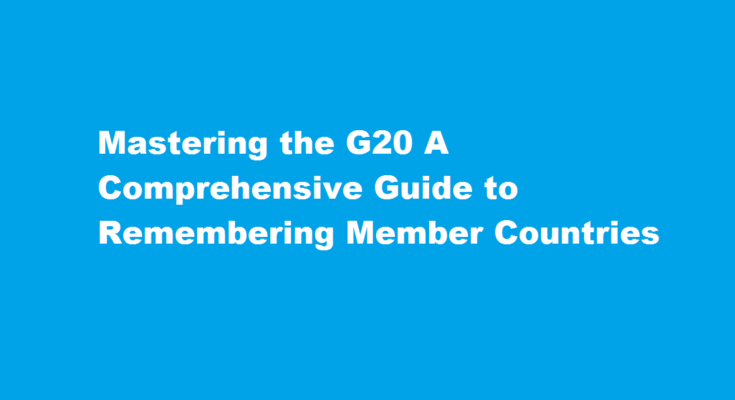Introduction
The Group of Twenty (G20) comprises the world’s leading economies, playing a vital role in global governance. To fully understand and engage with international affairs, it is essential to remember the member countries of this influential group. In this article, we present effective techniques to help you memorize the G20 countries effortlessly.
Visual Association
Visual association is a powerful mnemonic technique that leverages the brain’s capacity to remember images vividly. Create mental images by associating each G20 member country with a distinct visual cue. For example, imagine the United States as a soaring bald eagle, Germany as a precision-engineered automobile, and India as the iconic Taj Mahal. The more unique and memorable the associations, the easier it becomes to recall the corresponding countries.
Acronyms and Acrostics
Acronyms and acrostics provide a systematic approach to memorization. Create an acronym using the first letter of each G20 member country. For instance, “BAFUIJIKARCMMSASTIWBRASO” represents Brazil, Argentina, France, the United States, Italy, Japan, and so on. Alternatively, construct an acrostic by forming a memorable phrase or sentence using the first letter of each country. For example, “Brazil’s Amazing Football Team Unites Its Jovial Kids And Radiant Carnival Mood Makes Spectators Awestruck!” Such creative aids greatly enhance retention and recall.
Grouping Strategies
Grouping countries based on common characteristics or geographical regions can facilitate memorization. Divide the G20 countries into smaller subgroups, such as continents or economic blocs. For instance, you can group Canada, the United States, and Mexico as North American members, or China, Japan, and South Korea as representatives of East Asia. Focusing on these subgroups helps establish connections and promotes a deeper understanding of regional dynamics, making it easier to remember each country.
Memory Palaces
The Memory Palace technique involves mentally visualizing familiar locations, such as your home, and associating each G20 country with specific objects within those locations. For example, visualize the living room sofa as a representation of the United States, the kitchen sink as Germany, and the bedroom window as China. As you mentally navigate your memory palace, you can effortlessly recall the corresponding countries by visualizing the associated objects. This technique takes advantage of spatial memory, creating a strong mental framework for retention.
Repetition and Recall
Repetition is a time-tested method to reinforce memory. Regularly review the G20 member countries by using flashcards, quizzes, or online resources. Test your recall regularly to gauge your progress and identify areas that require more attention. Additionally, engage in discussions or participate in activities related to global economics and politics to reinforce your understanding of the G20 and its member countries. Application of knowledge in real-world contexts deepens your memory and comprehension.
FREQUENTLY ASKED QUESTIONS
How do you remember all the G20 countries?
G-Germany • U-USA • R-Russia • U-UK • J-Japan • I-Italy • S-Saudi Arabia • I-Indonesia • T-Turkey • A– Argentina • A-Australia • B-Brazil • S– South Africa • S– South Korea • C-Canada • F-France • C-China • IN-India • M-Mexico • E-European Union.
Who is Sherpa in G20?
India’s G20 Sherpa Shri Amitabh Kant will also lead discussions with the G20 Troika comprising India, Indonesia and Brazil.
Conclusion
Mastering the G20 member countries is an achievable task with the right techniques and practice. By employing visual association, acronyms, acrostics, grouping strategies, memory palaces, and consistent repetition, you can effortlessly remember the G20 countries and strengthen your understanding of global governance. Embrace these methods and embark on your journey to become a knowledgeable global citizen.
Read Also : Efficient Group Management and Operations in Tally A Comprehensive Guide



